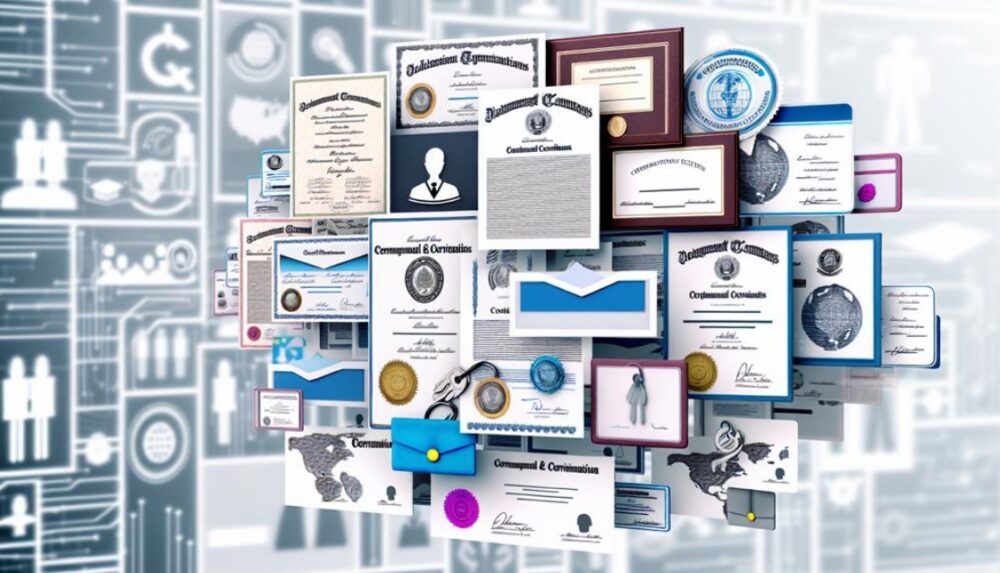They say that knowledge is power, and in today’s rapidly evolving workplace, staying ahead of the curve is crucial.
Enter enterprise e-learning, a game-changer in the world of workplace development. With its ability to provide customized learning paths, cost-effective training solutions, enhanced employee engagement and retention, and measurable learning outcomes, enterprise e-learning is revolutionizing the way organizations approach employee development.
But what exactly is enterprise e-learning, and how can it benefit your organization? Stay tuned as we explore the advantages and potential of this innovative approach to workplace learning.

Advantages of Enterprise E-Learning
Enterprise e-learning offers numerous benefits for employee skill development and remote learning opportunities. Firstly, it allows organizations to provide consistent and standardized training programs to employees regardless of their location. This is especially beneficial for companies with multiple branches or remote workers, as it ensures that all employees receive the same level of training and knowledge.
Additionally, enterprise e-learning offers flexibility in terms of scheduling and accessibility. Employees can access training materials and courses at their own pace and convenience, allowing them to fit learning around their work responsibilities. Moreover, e-learning platforms often incorporate interactive and multimedia elements, making the learning experience more engaging and effective. This can enhance employee motivation and retention of information.
Furthermore, enterprise e-learning enables organizations to track and measure employee progress and performance. This data can be used to identify knowledge gaps and areas where additional training is required.
Customized Learning Paths for Employees
Customized learning paths for employees play a crucial role in maximizing the effectiveness of enterprise e-learning programs. Personalized training programs allow employees to acquire the specific knowledge and skills they need to succeed in their roles, enabling them to enhance their performance and contribute effectively to the organization.
By tailoring the learning experience to individual needs, adaptive learning approaches ensure that employees receive the right content, at the right time, and in the right format. This not only increases engagement but also enhances knowledge retention and application. Employees are more likely to stay motivated and committed to their learning journey when they can see the relevance and applicability of the content to their specific job responsibilities.
Through personalized training programs, employees can progress at their own pace, focusing on areas where they need more support or guidance. This leads to more efficient learning, as individuals can bypass topics they’re already familiar with, saving time and effort. Additionally, adaptive learning approaches can provide real-time feedback and assessments, allowing employees to track their progress and identify areas for improvement.
Customized learning paths also foster a culture of continuous learning and development within the organization. By tailoring training to the specific needs and goals of employees, organizations demonstrate their commitment to investing in their workforce’s growth and success.

Cost-Effective Training Solutions
Implementing cost-effective training solutions is essential for organizations looking to optimize their e-learning programs and maximize the return on their investment. Interactive learning and virtual classrooms offer cost-effective alternatives to traditional training methods, allowing companies to train employees efficiently while reducing expenses.
Interactive learning engages employees through active participation, enhancing knowledge retention and application. By incorporating multimedia elements such as videos, quizzes, and simulations, organizations can create engaging and interactive training materials that cater to different learning styles. This not only improves the effectiveness of the training but also reduces the need for expensive in-person training sessions.
Virtual classrooms provide a cost-effective solution for delivering training to geographically dispersed employees. Through web-based platforms, organizations can conduct live training sessions where participants can interact with instructors and peers in real-time. This eliminates the need for travel and accommodation expenses associated with traditional classroom training. Additionally, virtual classrooms allow for the recording and playback of sessions, enabling employees to access the training materials at their convenience, further reducing costs.
Furthermore, cost-effective training solutions can be achieved by leveraging existing technologies and resources. By repurposing existing content or utilizing open-source e-learning platforms, organizations can save on development costs. Additionally, implementing a learning management system (LMS) can streamline the management and delivery of training materials, reducing administrative costs and increasing efficiency.
Enhanced Employee Engagement and Retention
Employee engagement and retention are crucial factors in the success of any organization. In today’s competitive business landscape, companies need to find effective ways to enhance employee motivation and talent development. One solution that has gained popularity is enterprise e-learning.
By offering a flexible and accessible platform for training and development, e-learning programs can significantly contribute to employee engagement and retention.
E-learning provides employees with the opportunity to learn at their own pace and in a format that suits their individual learning preferences. This personalized approach to training can greatly enhance employee motivation, as it allows them to take ownership of their professional development. Additionally, e-learning programs often incorporate interactive elements such as quizzes, simulations, and gamification, which further contribute to employee engagement.
Furthermore, e-learning is a cost-effective solution for talent development. Traditional training methods can be expensive, especially when considering factors such as travel expenses and instructor fees. With e-learning, companies can deliver training materials online, reducing costs while still providing high-quality content.

Measurable Learning Outcomes and ROI
Measuring the learning outcomes and return on investment (ROI) of enterprise e-learning initiatives is essential for organizations to assess the effectiveness and value of their training programs. Assessing learning effectiveness allows companies to determine if their e-learning initiatives are achieving the desired outcomes and if employees are acquiring the necessary knowledge and skills. By tracking employee performance, organizations can identify areas of improvement and address any gaps in knowledge or skills. This data-driven approach helps organizations make informed decisions about their training investments and allocate resources effectively.
One way to measure learning outcomes is through assessments and quizzes that evaluate employees’ understanding of the material. These assessments can be designed to test both knowledge retention and the application of skills in real-world scenarios. Additionally, organizations can track employee performance through learning management systems (LMS) that capture data on completion rates, engagement levels, and course evaluations.
Return on investment (ROI) is another crucial aspect to consider when evaluating e-learning initiatives. Organizations can calculate ROI by comparing the cost of implementing the e-learning program with the benefits it brings, such as improved employee performance, increased productivity, or reduced training costs. This analysis helps organizations justify their investments in e-learning and make informed decisions about future training strategies.
Frequently Asked Questions
How Does Enterprise E-Learning Improve Collaboration and Communication Among Employees?
Enterprise e-learning improves collaboration and communication among employees by providing a platform for enhanced knowledge sharing and improved productivity. It allows you to access training materials anytime, anywhere, promoting a collaborative and efficient work environment.
What Are the Potential Challenges or Barriers to Implementing Customized Learning Paths for Employees?
Challenges and implementation barriers to customized learning paths for employees include resistance to change, lack of technological infrastructure, and difficulty in aligning individual learning needs with organizational goals.
Can Enterprise E-Learning Be Accessed Remotely, Allowing Employees to Learn at Their Own Pace and Convenience?
You can access enterprise e-learning remotely, allowing you to learn at your own pace and convenience. It’s like having a personal tutor available whenever and wherever you need them.

How Does Cost-Effective Training Through Enterprise E-Learning Compare to Traditional In-Person Training Methods?
Cost-effective e-learning training methods offer advantages over traditional in-person training. With e-learning, you can save on travel expenses, facility rentals, and instructor fees, while still providing effective and flexible training opportunities.
Can Enterprise E-Learning Provide Personalized Feedback and Progress Tracking for Individual Employees?
Enterprise e-learning can provide personalized coaching and performance tracking for you. It allows for individualized feedback and progress monitoring, ensuring that your development is tailored to your specific needs and goals.





